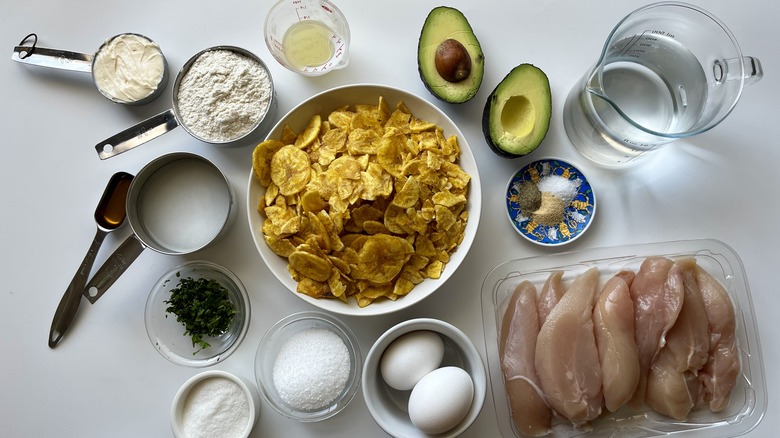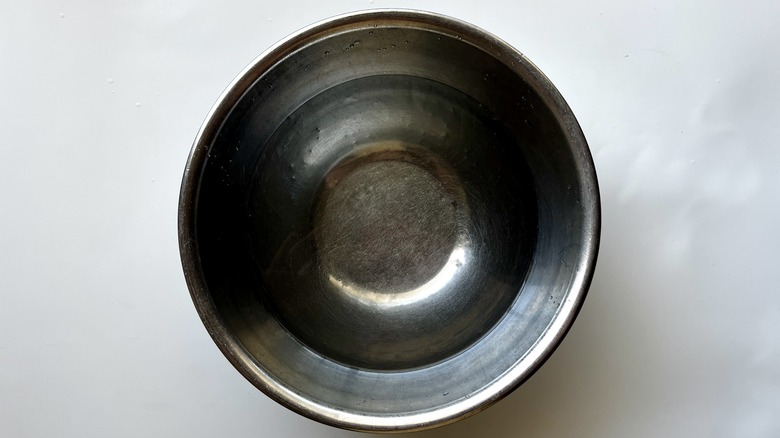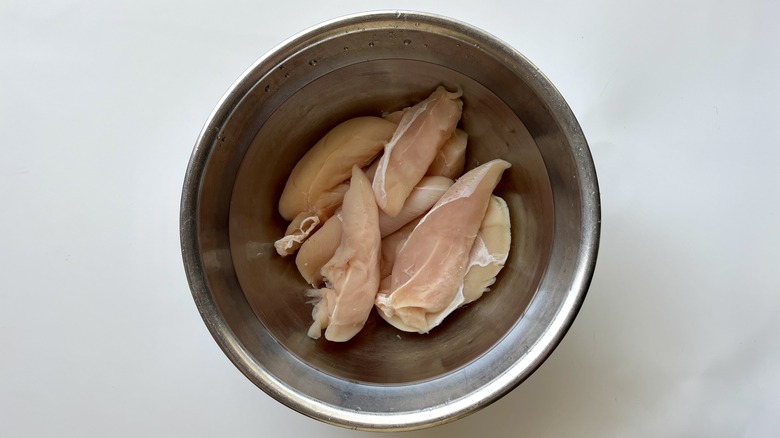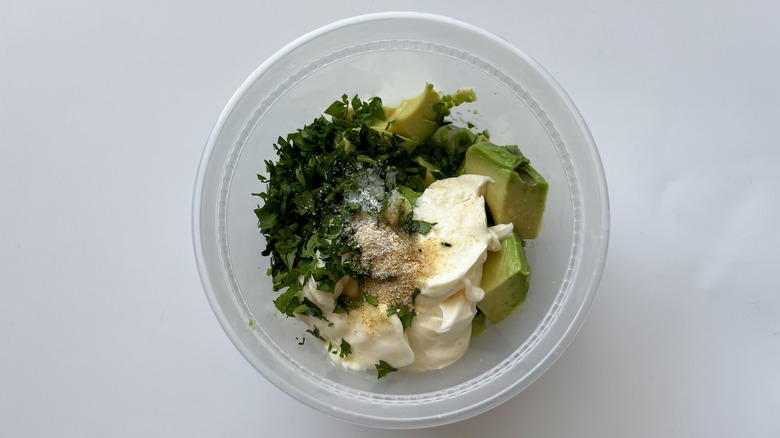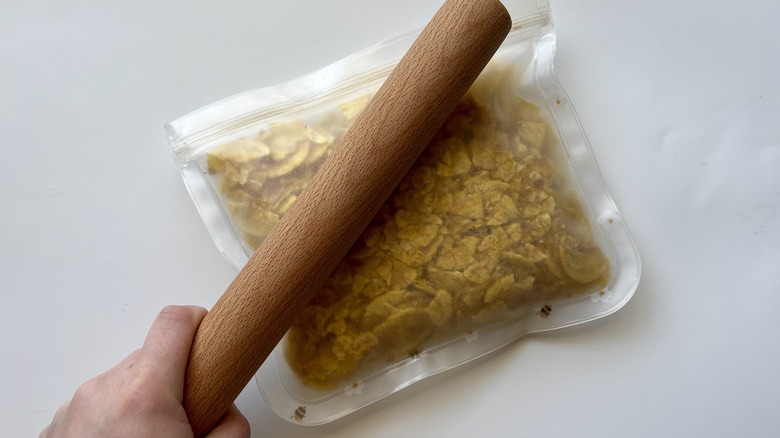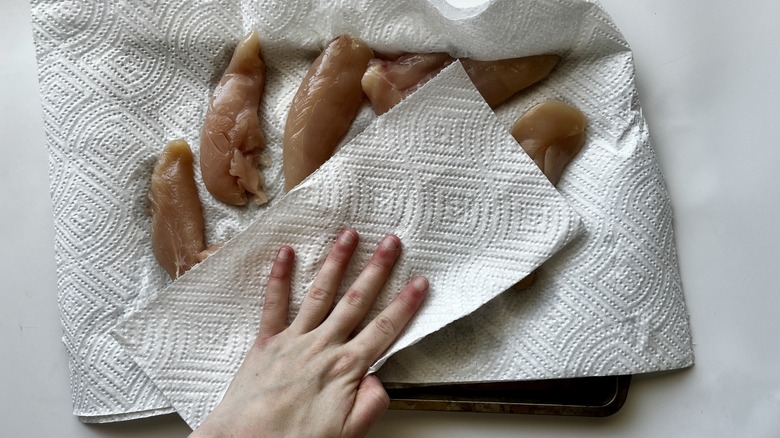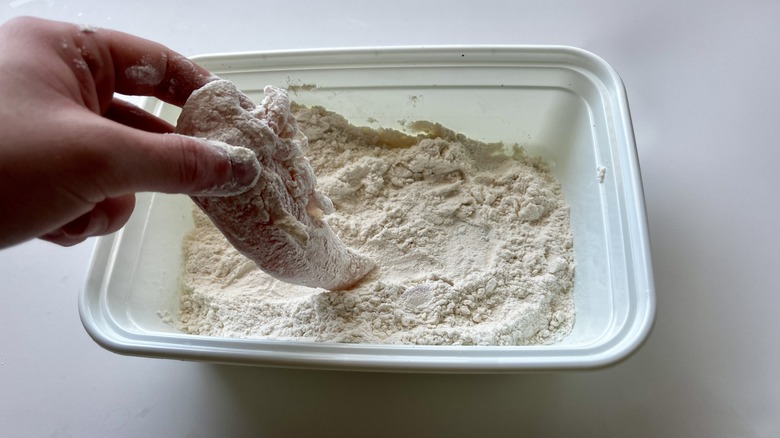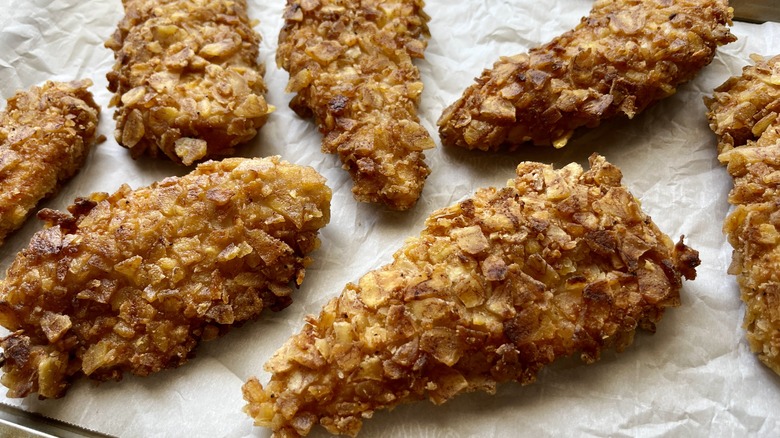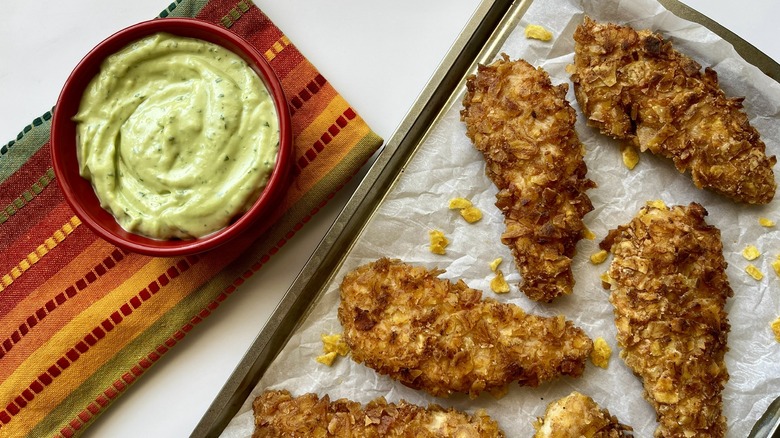Plantain-Crusted Chicken Fingers Recipe
Coating chicken fingers in crushed plantain chips? What a fantastically flavorful idea! As recipe developer Tess Le Moing says of her inspiration, "I love plantain chips because they're so incredibly crunchy. I also love my chicken tenders crunchy. " For this reason, she decided to introduce these two favorites, and the result is a marriage made in food heaven. From the juiciness of the brine-bathed chicken tenders to the salty-sweet crumb coating and the honey-lime avocado dip, this dish is sure to please kids and grow-ups alike.
Any kind of plantain chips will work for this recipe, whether thick or thin, plain or flavored. (FYI: The Barnana brand, which makes plantain and banana chips, made our list of healthiest chip brands, and they taste pretty great, too.) When you crush the chips, though, be sure to leave the crumbs pretty coarse — bigger crumbs make for crunchier chicken. Did we forget to mention that plantain chips are a gluten-free food? That means that with one simple ingredient swap (cornstarch in place of flour), these chicken fingers can be fully gluten-free, too.
Collect the ingredients for the plantain-crusted chicken fingers
The chicken fingers are made from chicken tenderloins that are brined in salt and sugar and coated in flour, egg, and plantain chips before you fry them in cooking oil. Fun fact: If you swap out the tenders for cod, haddock, or sea bass, the recipe also makes fabulous fish sticks. As for the dipping sauce, this starts with a base of mashed avocado and mayonnaise like a creamy guacamole. What really elevates it, though, is the flavorings: honey, lime juice, cilantro, garlic, and pepper.
Step 1: Prepare the brine
Add 1 quart water, the salt, and sugar to a large mixing bowl. Stir until the salt and sugar dissolve.
Step 2: Brine the chicken
Add the chicken tenders to the water and place in the fridge while you prepare the other ingredients.
Step 3: Prepare the ingredients for the avocado dip
Place all of the avocado dip ingredients into a pint container.
Step 4: Blend the avocado dip
Use an immersion blender to blend until smooth. Alternatively, use a food processor or blender. Cover and chill in the fridge.
Step 5: Crush the chips
Place the plantain chips in a zip-top bag and use a rolling pin to finely crush them. Alternatively, use a food processor.
Step 6: Put the crumbs in a bowl
Transfer the ground plantain chips to a shallow bowl.
Step 7: Put the flour and eggs in bowls
Pour the flour into a second shallow bowl and beat the eggs in a third shallow bowl.
Step 8: Dry the chicken
Pat the chicken dry with paper towels.
Step 9: Flour the chicken
Dredge the chicken in flour, shaking off any excess.
Step 10: Dip the chicken in egg
Then, dip the chicken in the beaten eggs, allowing any excess to drip off.
Step 11: Coat the chicken in crumbs
Lastly, coat the chicken in the plantain chips, pressing to adhere.
Step 12: Fry the first batch
Heat a 12-inch skillet over medium-high heat, then add the oil. Working in batches, add the coated chicken and cook until golden brown and cooked through, about 5 minutes per side.
Step 13: Finish frying the fingers
Transfer the chicken to a paper towel–lined tray and repeat with remaining chicken tenders.
Step 14: Eat the chicken fingers and avocado dip
Serve with the avocado dip.
Plantain-Crusted Chicken Fingers Recipe
Swap out the breadcrumbs for crushed plantain chips when you make fried chicken, and serve the crispy tenders with a simple avocado mayonnaise.

Ingredients
- For the chicken fingers
- ¼ cup kosher salt
- ¼ cup granulated sugar
- 1 ½ pounds chicken tenderloins
- 8 ounces (about 4 cups) plantain chips
- ½ cup all-purpose flour (or cornstarch, for gluten-free)
- 2 large eggs
- ¾ cup peanut oil (or other neutral oil), for frying
- For the avocado dip
- 1 ripe avocado, diced
- ⅓ cup mayonnaise
- 2 tablespoons lime juice
- 1 tablespoon honey
- 1 tablespoon minced fresh cilantro
- ¼ teaspoon garlic powder
- ¼ teaspoon kosher salt
- ⅛ teaspoon ground black pepper
Directions
- Add 1 quart water, the salt, and sugar to a large mixing bowl. Stir until the salt and sugar dissolve.
- Add the chicken tenders to the water and place in the fridge while you prepare the other ingredients.
- Place all of the avocado dip ingredients into a pint container.
- Use an immersion blender to blend until smooth. Alternatively, use a food processor or blender. Cover and chill in the fridge.
- Place the plantain chips in a zip-top bag and use a rolling pin to finely crush them. Alternatively, use a food processor.
- Transfer the ground plantain chips to a shallow bowl.
- Pour the flour into a second shallow bowl and beat the eggs in a third shallow bowl.
- Pat the chicken dry with paper towels.
- Dredge the chicken in flour, shaking off any excess.
- Then, dip the chicken in the beaten eggs, allowing any excess to drip off.
- Lastly, coat the chicken in the plantain chips, pressing to adhere.
- Heat a 12-inch skillet over medium-high heat, then add the oil. Working in batches, add the coated chicken and cook until golden brown and cooked through, about 5 minutes per side.
- Transfer the chicken to a paper towel–lined tray and repeat with remaining chicken tenders.
- Serve with the avocado dip.
Nutrition
| Calories per Serving | 1,480 |
| Total Fat | 108.8 g |
| Saturated Fat | 21.2 g |
| Trans Fat | 0.1 g |
| Cholesterol | 170.2 mg |
| Total Carbohydrates | 95.8 g |
| Dietary Fiber | 7.7 g |
| Total Sugars | 18.5 g |
| Sodium | 1,032.8 mg |
| Protein | 32.2 g |
What are some helpful tips for coating and frying chicken?
Le Moing has a favorite mnemonic device to help her remember the correct order for coating foods for frying: "FEBruary," with the first three letters standing for flour, egg, and breadcrumbs. If you hate it when the crumbs stick to your fingers, the best way around this is to use one of your hands for the egg dip and the other to dip the chicken in flour and breadcrumbs (or plantain chip crumbs, in the case of this recipe). With the flour and egg, be sure to shake off any excess, but with the crumbs, press them firmly into the chicken to help them stay put.
Successful frying starts with choosing the right oil, one with a high smoke point and a neutral flavor. Olive oil isn't a great choice for frying since it can't sustain the high temperatures needed to produce a crispy crust, but corn oil makes an excellent (and budget-friendly) option. Peanut, canola, and avocado oils will all work, too.
Once you've chosen your oil, heat it to anywhere between 300 F and 325 F, using a deep-fry thermometer to monitor the temperature. If you let the oil get too hot, the coating on the chicken may burn. If the oil isn't hot enough, the chicken will need to cook longer and, as a result, will absorb more oil, which may make the coating soggy.
Can I bake or air fry plantain-crusted chicken tenders?
If you don't want to bother with the mess and fuss of deep frying, you can also bake these chicken tenders in the oven. Preheat it to 400 F, and as it heats, prepare a sheet pan by either lining it with parchment paper or greasing it to prevent the chicken from sticking. You can also spritz the chicken tenders with oil to give them a little of that just-fried flavor and to help make the plantain chip coating extra crunchy. Bake the chicken fingers for about 10 minutes, then flip them over and continue baking for another 10 minutes or so, until they reach an internal temperature of 165 F.
If you have an air fryer, which is essentially a mini convection oven, this can also work for cooking the chicken. As this smaller appliance puts out more concentrated heat, the fingers can cook at 375 F and it will just take 10 minutes (again, turn them over at the halfway point). Unless you have an extra-large air fryer, though, you may need to cook them in batches.

